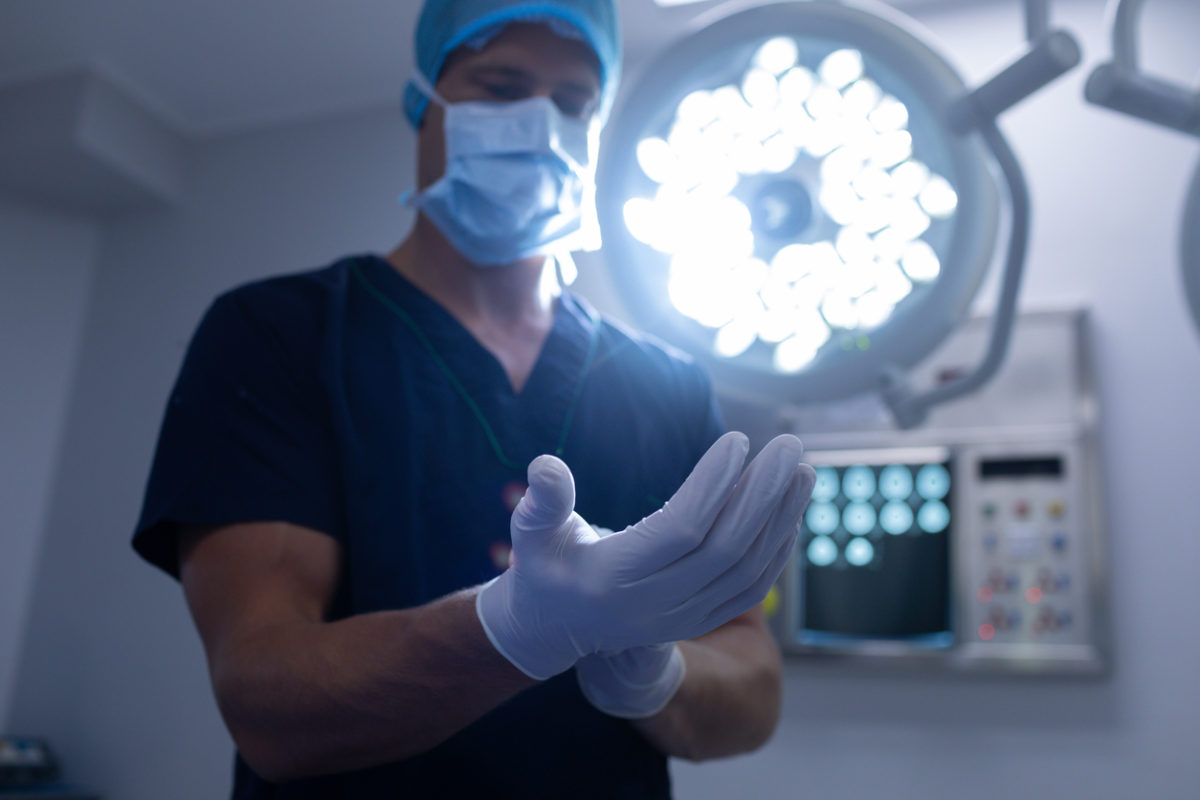Postanesthetic Shivering

Though local and general anesthesia are generally very safe, they are often accompanied by mild to moderate side effects.1,2 These include dizziness, headache, blurry vision, twitching muscles,1 nausea, vomiting, dry mouth, sore throat, muscle aches, itching, sleepiness and hoarseness.2 A common side effect in local (e.g., spinal, epidural, etc.) as well as general anesthesia is postanesthetic shivering.2 Postanesthetic shivering is a leading cause of discomfort among patients recovering from anesthesia, with prevalence rates ranging from 20 to 70 percent.3 In order to provide the best care to their patients, anesthesia providers should be aware of the complexities of postanesthetic shivering and recent studies on potential solutions.
Postanesthetic shivering can have thermoregulatory or non-thermoregulatory origins. The major cause of shivering is perioperative hypothermia, which sets in due to anesthesia-induced inhibition of thermoregulation.4 However, postanesthetic shivering can also be associated with cutaneous vasodilation (i.e., widening of blood vessels in the skin) from perioperative pain4 or spinal hyperreflexia (i.e., overactive reflexes) from residual anesthetic drugs.5 The physiology of the body’s thermoregulation system is complicated, but in the simplest terms, normal thermoregulatory shivering is caused by cold stimulation of the spinal cord and skin, which leads to motor neuron reactions.6 Yet in some patients, a postoperative increase in body temperature (i.e., hyperthermia or fever) may also be associated with shivering.7 Additionally, many patients with low body temperature do not shiver and many with normal body temperatures do shiver.7 This suggests that other factors may be involved, such as pain and surgical stress.5 As stated in a paper by Lopez, acute opioid withdrawal or use of particular anesthetics can cause postanesthetic shivering.6 Shivering not only causes discomfort and aggravates patients’ pain, but it also increases metabolic demand of muscles, including the heart.4 However, the data does not indicate higher risk of cardiac events for patients with postoperative shivering.4,7 Shivering also increases oxygen consumption and carbon dioxide production, but its association with hypoxia prevents hypoxemia from occurring.7 Whether shivering is thermoregulatory or non-thermoregulatory, it can be an unpleasant experience for patients and clinicians alike.
There are many pharmacological and nonpharmacological ways to prevent or end postanesthetic shivering.6 According to independent articles by Lopez and Golembiewski, active cutaneous warming such as electric, forced-air and radiant heating or water-circulating garments are effective in reducing hypothermia and associated shivering.6,8 Alfonsi also recommends active skin surface rewarming in order to rapidly pass the shivering threshold.4 Warming the patient may even be advisable during the preoperative period in order to prepare the body for thermal dysregulation.6 As found in a study by Yeh et al., preoperative prophylaxis with electroacupuncture may also effectively reduce postanesthetic shivering from bupivacaine.9 Meanwhile, pharmacological agents, which act by reducing the shivering threshold temperature, may be the most efficient techniques for reducing postanesthetic shivering.4 These include meperidine, clonidine, tramadol and others.4 In a study by Nakagawa et al., tramadol administered at induction of remifentanil anesthesia effectively suppressed postanesthetic shivering.10 Yousuf et al. found similar efficacy of tramadol for propofol induction, but not for thiopentone.11 Additionally, Horn et al. found that physostigmine, meperidine and clonidine were all effective in reducing postoperative shivering after propofol and fentanyl administration.12 Furthermore, Usta et al.’s study on dexmedetomidine showed a marked decrease in shivering associated with spinal anesthesia with hyperbaric bupivacaine.13 Even acetaminophen, such as Tylenol, can prevent postoperative shivering.14 Evidently, prevention and cessation of postanesthetic shivering can be induced by a variety of pharmacological and nonpharmacological strategies.
Anesthesia is associated with several mild to moderate side effects, including postanesthetic shivering. Shivering can be caused by thermoregulatory or non-thermoregulatory mechanisms, including pain or opioid withdrawal. Prevention efforts include skin warming techniques, electroacupuncture and several shiver threshold-lowering medications. Given the wide range of possible solutions, future research should aim to develop standardized, evidence-based anti-shivering protocols.15 Additionally, scientists should further investigate the nebulous etiologies of shivering.
1. National Health Service. Local anaesthesia. Health A to Z July 23, 2018; https://www.nhs.uk/conditions/local-anaesthesia/.
2. Mayo Clinic. General anesthesia. Tests & Procedures December 4, 2018; https://www.mayoclinic.org/tests-procedures/anesthesia/about/pac-20384568.
3. Eberhart LH, Doderlein F, Eisenhardt G, et al. Independent risk factors for postoperative shivering. Anesthesia & Analgesia. 2005;101(6):1849–1857.
4. Alfonsi P. Postanaesthetic shivering: Epidemiology, pathophysiology, and approaches to prevention and management. Drugs. 2001;61(15):2193–2205.
5. Bock M, Motsch J. Postanesthetic Shivering. In: Kosaka M, Sugahara T, Schmidt KL, Simon E, eds. Thermotherapy for Neoplasia, Inflammation, and Pain. Tokyo: Springer Japan; 2001:146–151.
6. Lopez MB. Postanaesthetic shivering—From pathophysiology to prevention. Romanian Journal of Anaesthesia and Intensive Care. 2018;25(1):73–81.
7. De Witte J, M.D., Sessler Daniel I, M.D. Perioperative Shivering: Physiology and Pharmacology. Anesthesiology: The Journal of the American Society of Anesthesiologists. 2002;96(2):467–484.
8. Golembiewski J. Pharmacological Management of Perioperative Shivering. Journal of PeriAnesthesia Nursing. 2015;30(4):357–359.
9. Yeh B-Y, Hsu Y-C, Huang J-Y, et al. Effect of electroacupuncture in postanesthetic shivering during regional anesthesia: A randomized controlled trial. BMC Complementary and Alternative Medicine. 2012;12(1):233.
10. Nakagawa T, Hashimoto M, Hashimoto Y, Shirozu K, Hoka S. The effects of tramadol on postoperative shivering after sevoflurane and remifentanil anesthesia. BMC Anesthesiology. 2017;17(1):1.
11. Yousuf B, Samad K, Ullah H, Hoda M. Efficacy of tramadol in preventing postoperative shivering using thiopentone or propofol as induction agent: A randomized controlled trial. Journal of Anaesthesiology Clinical Pharmacology. 2013;29(4):521–525.
12. Horn E-P, MD, Standl T, MD, Sessler Daniel I, MD, von Knobelsdorff G, MD, Buchs C, Schulte am Esch J, MD. Physostigmine Prevents Postanesthetic Shivering As Does Meperidine or Clonidine Anesthesiology: The Journal of the American Society of Anesthesiologists. 1998;88(1):108–113.
13. Usta B, Gozdemir M, Demircioglu RI, Muslu B, Sert H, Yaldiz A. Dexmedetomidine for the prevention of shivering during spinal anesthesia. Clinics (Sao Paulo). 2011;66(7):1187–1191.
14. Kinjo T, Tadokoro T, Tokushige A, et al. Effects of Perioperative Administration of Acetaminophen on Postoperative Shivering: A Randomized, Triple-Blind, Placebo-Controlled Trial. Anesthesia & Analgesia. June 24, 2019.
15. Choi KE, Park B, Moheet AM, Rosen A, Lahiri S, Rosengart A. Systematic Quality Assessment of Published Antishivering Protocols. Anesthesia & Analgesia. 2017;124(5):1539–1546.